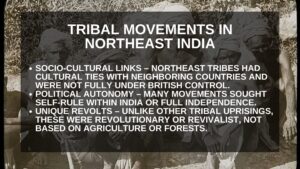Tribal communities in India have historically lived in rural and forested areas, maintaining a distinct identity despite interactions with non-tribal populations. These communities had their own socio-political and economic structures, relying on land and forests for sustenance. However, British colonial policies disrupted their traditional way of life, leading to several tribal uprisings against the British and other external forces.
Key Features of Tribal Movements
- Identification of Enemies – The tribals categorized their enemies as ‘dikus’ (outsiders), including landlords, moneylenders, missionaries, and British officials. However, they did not consider poor laborers or professionals as enemies.
- Socio-Religious Aspects – Many tribal movements had religious and social elements, but they were primarily driven by issues related to their survival and rights.
- Local Leadership – These revolts were often led by charismatic tribal leaders who were seen as messiah-like figures.
- Use of Traditional Weapons – The tribal rebels fought using bows, arrows, lathis, and axes.
- Violent Nature – Many of these uprisings turned violent, resulting in attacks on oppressors and destruction of their properties.
Download notes of Peasant Movements in India
Causes of Tribal Movements
- Disruption of Land Ownership – British land policies undermined the joint ownership system among tribes, leading to loss of land and social disruption.
- Agricultural Expansion – The introduction of settled agriculture led to an influx of non-tribal outsiders, displacing many tribal people.
- Ban on Shifting Cultivation – Restrictions on shifting cultivation in forests deprived tribals of their traditional livelihood.
- Creation of Reserved Forests – The British imposed restrictions on timber use and grazing, increasing their control over forested regions.
- Exploitation by Outsiders – Police, traders, and moneylenders exploited tribal people, worsening their plight.
- Intrusion in Traditional Practices – British laws interfered with tribal customs and governance systems.
- Role of Christian Missionaries – The spread of Christianity was seen as an attack on traditional tribal beliefs, leading to resistance against missionaries.
Tribal Movements in Northeast India
The tribal uprisings in Northeast India had unique characteristics:
- Socio-Cultural Links – Northeast tribes had cultural connections with neighboring countries and were not fully integrated into British rule.
- Political Autonomy – Many movements demanded autonomy within India or complete independence.
- Distinct Nature of Revolts – Unlike other tribal movements, these were not agrarian or forest-based but had revolutionary or revivalist tendencies.

Notable Northeast Tribal Uprisings
1. Khasi Uprising (1830s)
- British control over the Brahmaputra Valley post-Anglo-Burmese War (1824-26) led to an influx of outsiders.
- Khasi chief U Tirot Sing led a revolt against the British but was suppressed by 1833.
2. Singphos Rebellion (1825-1849)
- The Singphos of Assam attacked British establishments multiple times between 1825 and 1849.
- The rebellion was ultimately crushed by the British.
Other minor revolts in the Northeast included the Mishmi Revolt (1836), Khampti Rebellion (1839-42), and Lushai Revolt (1842-44).
Mainland Tribal Movements in India
1. Pahariya Revolt (1778)
- The Pahariyas of Rajmahal Hills rebelled under Raja Jagannath against British forest clearance policies.
- The British later adopted appeasement policies to pacify them.
2. Chuar Uprising (1766-1809)
- The Bhumij tribe, known as Chuars, revolted in phases against British revenue policies.
- Major revolts took place in 1766, 1771, and 1798-99.
- The most notable leader was Durjan Singh, and later, Rani Shiromani in 1799.
3. Kol Mutiny (1831)
- The Kols of Chotanagpur revolted against land transfers to outsiders.
- Led by Buddhu Bhagat and others, the movement was suppressed by the British forces.
4. Ho and Munda Uprisings (1820-1837)
- The Ho and Munda tribes fought against British encroachments in Singhbhum and Chotanagpur.
- The rebellion continued until 1837.
5. Tilka Manjhi Revolt (1770-1785)
- Tilka Manjhi led the Santhal rebellion against British exploitation and was executed in 1785.
6. Santhal Rebellion (1855-56)
- Led by Sidhu and Kanhu Murmu, the Santhals revolted against landlords and the British.
- Though the rebellion was crushed, it led to the creation of Santhal Pargana.
Download notes of Advent of Europeans in India
Other Notable Tribal Revolts
| Revolt | Leader | Tribe/Region | Cause |
|---|---|---|---|
| Khond Uprising (1837-56) | Chakra Bisoi | Khond (Odisha, Andhra Pradesh) | British suppression of human sacrifice, new taxes, and loss of forest rights |
| Koya Revolt (1879-86) | Tomma Sora, Raja Anantayyar | Koya (Eastern Godavari, Andhra) | Exploitation by officials, loss of customary rights |
| Bhil Revolt (1817-19, 1825, 1831) | Seva Ram | Bhils (Western Ghats) | Economic distress, misgovernance, and oppression |
| Koli Risings (1829-48) | Various leaders | Kolis (Maharashtra) | Unemployment due to British policies |
Tribal movements in India were a response to colonial oppression, loss of traditional lands, and economic exploitation. These uprisings, though largely unsuccessful in overthrowing British rule, played a significant role in shaping India’s tribal policies and the future demand for tribal rights and autonomy.
Understanding these movements helps in appreciating the resilience of tribal communities and their ongoing struggles for rights and recognition.


